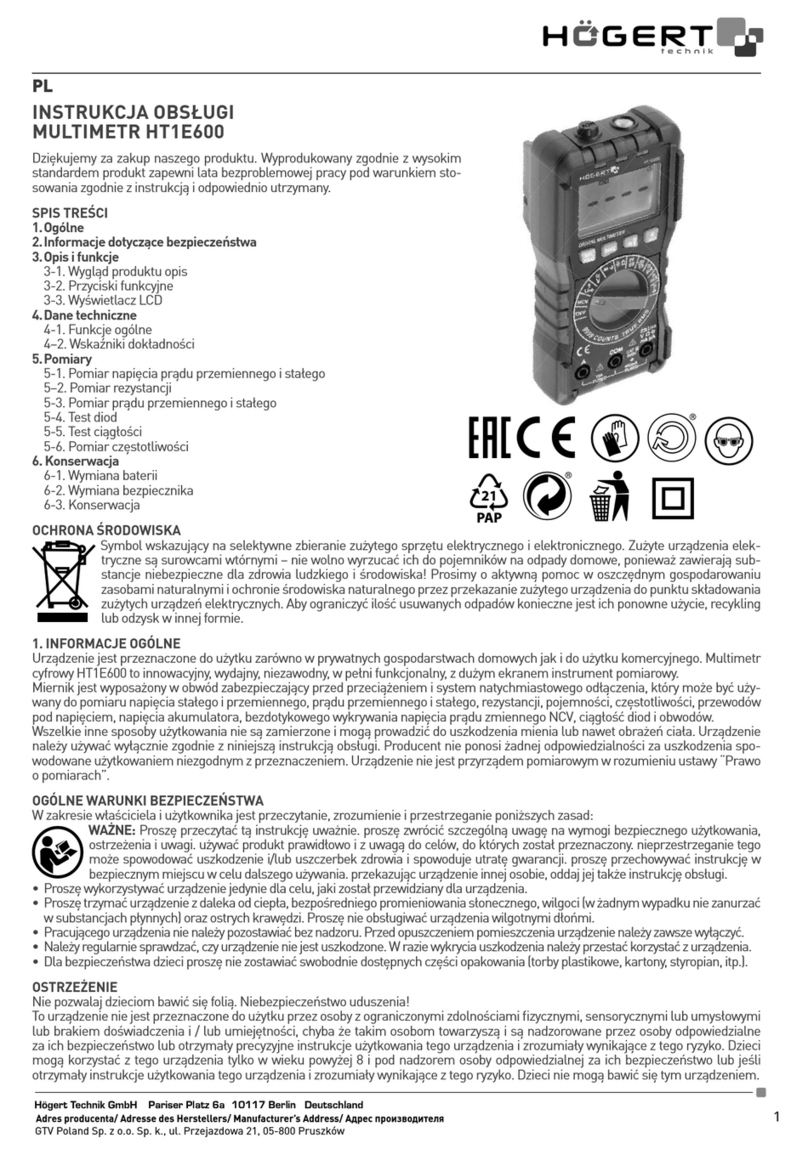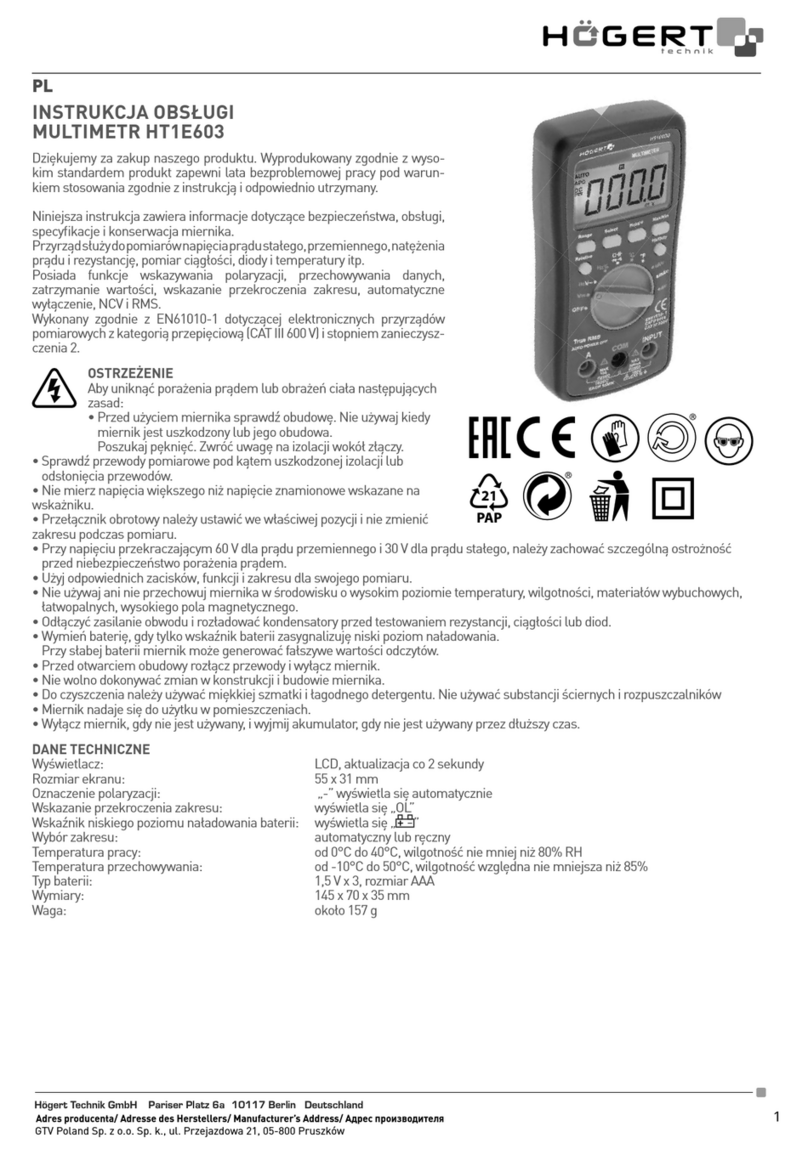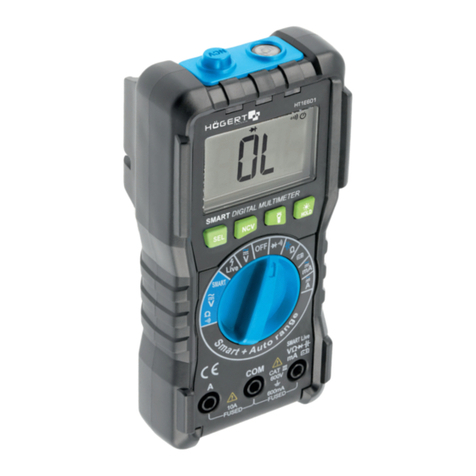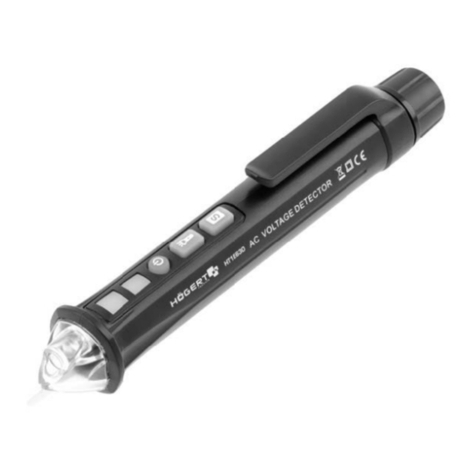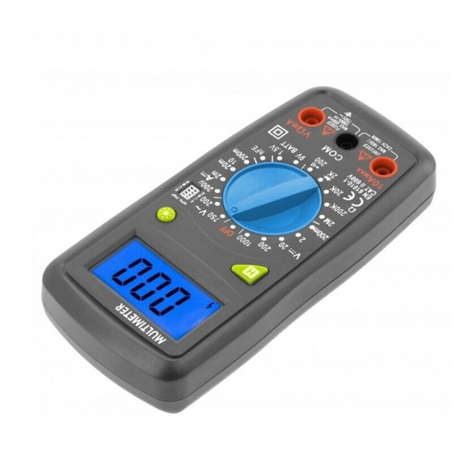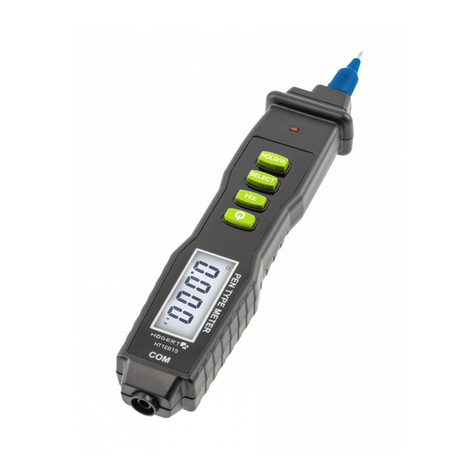
3
Adres producenta/ Adresse des Herstellers/ Manufacturer’s Address/ Адрес производителя
GTV Poland Sp. z o.o. Sp. k., ul. Przejazdowa 21, 05-800 Pruszków
POMIAR NCV:
Ustaw przełącznik obrotowy na pozycję NCV i zamknij detektor NCV na mierzonym przewodzie, przyrząd może wykryć, czy mierzony
przewód ma napięcie > 90V prądu przemiennego. Gdy instrument wykryje napięcie prądu przemiennego, uruchomi się brzęczyk alar-
mu, a podświetlenie będzie migać.
Uwaga: 1) Nawet jeśli nie ma alarmu, przewód może być pod napięciem. Na wykrycie mogą mieć wpływ takie czynniki, jak różne
konstrukcje gniazd i typy grubości izolacji itp.
POMIAR NAPIĘCIA PRĄDU STAŁEGO
1. Włóż czerwony wtyk do gniazda „INPUT” i czarny wtyk do gniazda „COM”.
2. Ustaw przełącznik zakresu funkcji na napięcie i naciśnij przycisk „SEL”, aby przejść do trybu pomiaru napięcia prądu stałego.
Podłącz sondę do mierzonego obiektu, a biegunowość zacisku połączonego czerwoną końcówką pokaże się na wyświetlaczu
w tym samym czasie.
3. Odczytaj wynik pomiaru z wyświetlacza.
POWIADOMIENIA!
∆ Jeśli zakres mierzonego napięcia nie jest wcześniej znany, należy ustawić przełącznik zakresu funkcji w pozycji maks. zasięg,
a następnie stopniowo zmniejszaj, aż do uzyskania satysfakcjonującej rozdzielczości.
∆ Podczas pomiaru wysokiego napięcia należy zwrócić szczególną uwagę, aby uniknąć porażenia prądem.
POMIAR NAPIĘCIA PRĄDU PRZEMIENNEGO
1. Włóż czerwony wtyk do gniazda „INPUT” i czarny wtyk do gniazda „COM”.
2. Ustaw przełącznik zakresu funkcji na napięcie i naciśnij przycisk „SEL”, aby przejść do trybu pomiaru napięcia prądu przemiennego.
Podłącz sondę do mierzonego obiektu, a biegunowość zacisku połączonego czerwoną końcówką pokaże się na wyświetlaczu w tym
samym czasie.
3. Odczytaj wynik pomiaru z wyświetlacza.
POWIADOMIENIA!
∆ Podczas pomiaru wysokiego napięcia należy zwrócić szczególną uwagę, aby uniknąć porażenia prądem. LowZ: pomiar niskiej
impedancji
1. Włóż czerwony wtyk do gniazda „INPUT” i czarny wtyk do gniazda „COM”.
2. Ustaw przełącznik zakresu funkcji na niską rezystancję i podłącz sonde do mierzonego obciążenia, podczas gdy biegunowość
terminala podłączonego przez czerwony sondę będzie jednocześnie wyświetlana na wyświetlaczu.
3. Odczytaj wynik pomiaru z wyświetlacza.
POWIADOMIENIA!
∆ Podczas pomiaru wysokiego napięcia należy zwrócić szczególną uwagę, aby uniknąć porażenia prądem.
POMIAR PRĄDU PRZEMIENNEGO
1. Ustaw przełącznik zakresu funkcji w zakresie pomiaru prądu przemiennego.
2. Naciśnij spust i otwórz głowicę zacisku, jednocześnie zaczepiając przewód w zacisku, aby zmierzyć prąd. Jednak nie można wykonać
pomiaru, gdy dwa lub trzy przewody są jednocześnie w zasięgu głowicy.
3. Odczytaj wynik pomiaru z wyświetlacza.
Uwaga: Jeśli zakres mierzonego prądu nie jest wcześniej znany, należy ustawić przełącznik zakresu funkcji w pozycji maks. zakres
prądu, a następnie stopniowo zmniejszaj, aż do uzyskania satysfakcjonującej rozdzielczości.
POMIAR REZYSTANCJI
1. Włóż czerwony i czarny wtyk odpowiednio do zacisków „INPUT” i „COM”.
2. Ustaw przełącznik zakresu funkcji na wymagany zakres Ω i podłącz sonde do mierzonej rezystancji.
3. Odczytaj wynik pomiaru z wyświetlacza.
Uwaga:
∆ Jeśli mierzona rezystancja przekracza maks. wartość wybranego zakresu, na wyświetlaczu pojawi się „OL”, w tym przypadku wy-
bierz wyższy zakres.
∆ Podczas sprawdzania rezystancji online wyłącz wszystkie zasilacze w mierzonym obwodzie i całkowicie rozładuj wszystkie konden-
satory.
∆ Podczas pomiaru rezystancji powyżej 1 MΩ stabilny odczyt można uzyskać dopiero po kilku sekundach. Jest to normalne w przypad-
ku pomiaru wysokiej rezystancji.
TEST DIOD
Włóż czerwony wtyk do gniazda „INPUT” i czarny do gniazda „COM”. W takim przypadku biegunowość czerwonego wtyku to „+”. Ustaw
przełącznik zakresu funkcji na , podłącz czerwony czujnik do dodatniej mierzonej diody i podłącz czarny do ujemnej. Odczyt na
wyświetlaczu to dodatni spadek napięcia mierzonej diody.
TEST WŁĄCZANIA / WYŁĄCZANIA OBWODU
Włóż czerwony wtyk do gniazda „Ω”, a czarny do gniazda „COM” i ustaw przełącznik zakresu funkcji na , jednocześnie podłącz
sonde do obu punktów mierzonego obwodu. Podczas testu przewodzenia brzęczyk zabrzmi, gdy zmierzona rezystancja jest mniejsza
niż 60 Ω, a brzęczyk może zabrzmieć lub nie zabrzmieć, gdy wynosi od 60 Ω do 120 Ω, a brzęczyk nie będzie emitował dźwięku, gdy
będzie większy niż 120 Ω.



